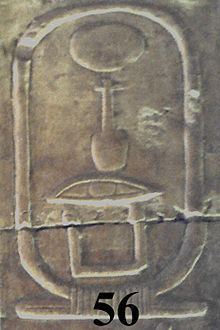Burial unknown | ||
 | ||
Reign 1 year and 6 months, c. 2160 BC (7th/8th Dynasty) Successor uncertain; possibly Meryibre Khety | ||
Neferirkare (sometimes referred to as Neferirkare II because of Neferirkare Kakai) was an ancient Egyptian pharaoh of the 7th/8th Dynasty during the early First Intermediate Period (2181–2055 BC). According to the egyptologists Kim Ryholt, Jürgen von Beckerath and Darell Baker he was the 17th and final king of the combined 7th/8th Dynasty. For many scholars, this makes Neferirkare the last pharaoh of the Old Kingdom, which comes to an end with the 8th Dynasty.
Contents
Attestations
Neferirkare II's name is clearly attested on the 56th entry of the Abydos King List, a king list which was redacted some 900 years after the First Intermediate Period during the reign of Seti I. The latest reconstruction of the Turin canon, another king list compiled in the Ramesside era, indicates that Neferirkare II is also attested there on column 5, line 13.
Identity
Farouk Gomaà, William C. Hayes and Baker identify Neferirkare II with the horus name Demedjibtawy (Dmḏ-ib-t3wy, "He who unifies the heart of the two lands") appearing on a single decree, the Coptos Decree R, now in the Egyptian Museum, JE 41894. The decree concerns the temple of Min at Coptos, exempting it from dues and duties. This identification is rejected by Jürgen von Beckerath.
Another proposed identification concerns the prenomen Wadjkare (W3ḏ-k3-Rˁ, "Flourishing is the Ka of Ra"), which also appears on the Coptos Decree R. Kurt Heinrich Sethe, Gomaà, Hayes and Baker see Wadjkare as distinct from Demedjibtawy, but von Beckerath believes that Wadjkare may have been the prenomen of Neferkare II and the same person as Demedjibtawy. At the opposite, Gomaà and Hayes equate Wadjkare with an obscure ruler named Hor-Khabaw. Alternatively, Hans Goedicke proposed that Wadjkare is the predecessor of Demedjibtawy and places both rulers chronologically into the 9th Dynasty. Thomas Schneider leaves the problem open and relates Wadjkare equally to either Neferkare II or Neferirkare II without further reference to Demedjibtawy.
Finally, both Demedjibtawy and Wadjkare are not known from any other contemporary attestation than the decree and, unless they are to be identified with Neferirkare II or Neferkare II, they are also absent from both the Abydos king list and the Turin canon.
In 2014 Maha Farid Mostafa published an inscription, found in the tomb of Shemay. The inscription belongs most likely to Idy, a son of Shemay, albeit Idy's name is not preserved. The text is dated under a king with the name Pepy and with a throne name Nefer-ka [destroyed]-Ra. Maha Farid Mostafa reconstructed that throne name to Neferirkare. The inscription dates for sure to the 8th Dynasty. If this reconstruction is correct, Neferirkare is most likely identical with Demedjibtawy. Idy is mentioned on one of the Coptos decrees together with Demedjibtawy .
Reign
The Turin canon credits Neferirkare II with a year and half of reign. Both the Turin canon and the Abydos king list record Neferirkare II as the last ruler of the combined 7th/8th. Neferirkare was possibly overthrown by the first king of the succeeding Herakleopolitan 9th Dynasty, Meryibre Khety. Alternatively the Egyptian state may have completely collapsed with the onset of low Nile floods, mass famine and chaos which engulfed Egypt at the start of the First Intermediate Period.
